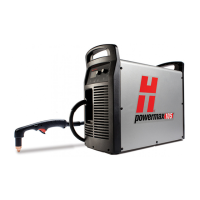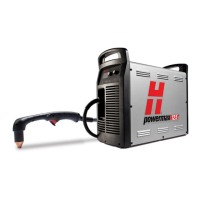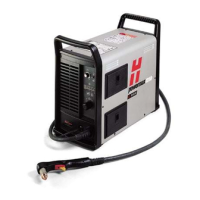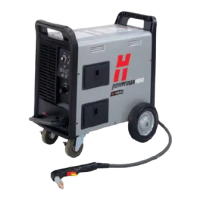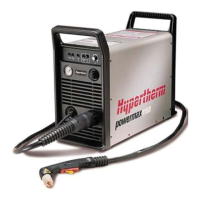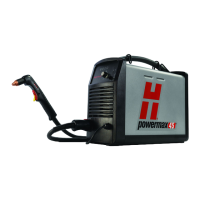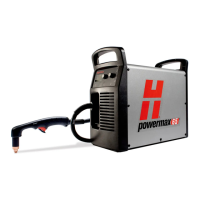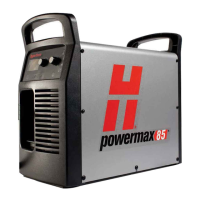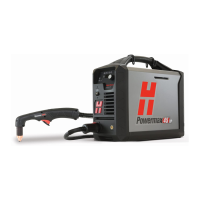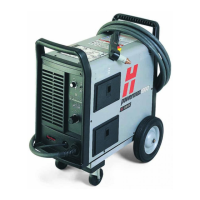MAINTENANCE
3-14 powermax1000 Service Manual
1
Problem This may mean Cause Solution
No voltage, improper voltage applied to
unit, defective power switch (S1), or
defective input diode.
Defective filter board (PCB1).
CE systems only: Measure the AC voltage at the CE filter. If no
voltage or low voltage, replace the filter board.
Defective power board (PCB2), fan, or
solenoid valve.
Disconnect J1 and J20 from power board and perform Test 6. If all
voltages are not present or if voltages are oscillating, replace the
power board. If the voltages are good, reconnect J1 and J20 one at a
time and perform Test 6. Replace the component that causes the
voltage to oscillate or drop.
Defective power board (PCB2) or IGBT
(Q6 or Q7).
Defective control board (PCB3). Replace the control board.
Defective power board (PCB2), fan, or
solenoid valve.
Disconnect J1 and J20 from power board and perform Test 6. If all
voltages are not present or if voltages are oscillating, replace the
power board. If the voltages are correct, reconnect J1 and J20 one at
a time and perform Test 6. Replace the component that causes the
voltage to oscillate or drop.
Defective power board (PCB2) or IGBT
(Q6 or Q7).
Defective control board (PCB3). Replace the control board.
System is in gas test mode.
The current adjustment knob is in the
gas test position.
Turn the knob clockwise until it is set at 20 amps or below.
Solenoid valve (V1) stuck open
or defective power board
(PCB2).
Faulty valve, power board (PCB2), or
control board (PCB3).
Voltage below proper operating limits,
or phase is lost.
Verify the incoming line voltage and the circuit size according to the
Operator Manual.
Faulty power board or control board. Perform Tests 5, 6, and 11.
No air supplied to unit. Connect air supply.
Dirty air filter element. Replace air filter element.
Restriction in air supply line. Replace the air supply line.
Air pressure setting below operating
requirements or incoming air pressure
is dropping when trying to fire the torch.
Turn the current adjustment knob to gas test and set the pressure to
70 psi (4.8 bar) for cutting and 50 (3.4 bar) for gouging as required for
system operation. Verify the gas source is within the setup
specifications in Section 2.
Faulty pressure sensor assembly or
control board.
Insufficient voltage to control
circuits, or shorted power
component.
Power On LED does not illuminate or
blinks when power switch is ON.
Insufficient air pressure.
Air pressure LED blinks yellow.
Improper line voltage or circuit
size.
Power On LED blinks, flashes, or
goes out while cutting.
Shorted power components.
Air flows from the torch at power-up
when neither the torch trigger nor
the start switch is activated.
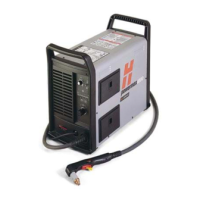
